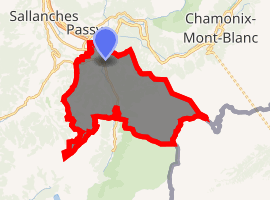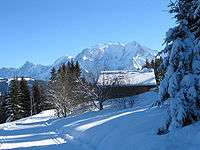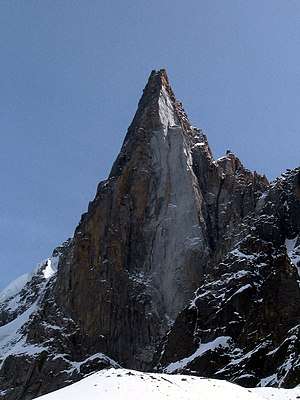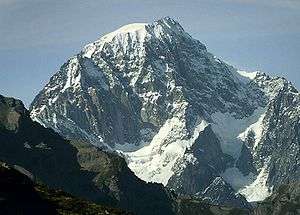Saint-Gervais-les-Bains
Saint-Gervais-les-Bains (French pronunciation: [sɛ̃ ʒɛʁvɛ le bɛ̃]) is a commune in the Haute-Savoie department in the Auvergne-Rhône-Alpes region in south-eastern France. The village is best known for tourism, and has been a popular holiday destination because of its beauty and location since the early 1900s. It has 450 km of ski pistes, reputed to be the third largest domain exclusively in France, and is one of the least busy ski areas of its size.[2] In 1892, two hundred people were killed when a water pocket in a glacier above the town suddenly burst open, causing destructive flooding.
Saint-Gervais-les-Bains | |
|---|---|
 A general view of Saint-Gervais-les-Bains | |
.svg.png) Coat of arms | |
Location of Saint-Gervais-les-Bains 
| |
 Saint-Gervais-les-Bains  Saint-Gervais-les-Bains | |
| Coordinates: 45°53′36″N 6°42′50″E | |
| Country | France |
| Region | Auvergne-Rhône-Alpes |
| Department | Haute-Savoie |
| Arrondissement | Bonneville |
| Canton | Le Mont-Blanc |
| Intercommunality | Pays du Mont-Blanc |
| Government | |
| • Mayor (2014-2020) | Jean-Marc Peillex |
| Area 1 | 63.63 km2 (24.57 sq mi) |
| Population (2017-01-01)[1] | 5,573 |
| • Density | 88/km2 (230/sq mi) |
| Time zone | UTC+01:00 (CET) |
| • Summer (DST) | UTC+02:00 (CEST) |
| INSEE/Postal code | 74236 /74170 |
| Elevation | 571–4,810 m (1,873–15,781 ft) |
| 1 French Land Register data, which excludes lakes, ponds, glaciers > 1 km2 (0.386 sq mi or 247 acres) and river estuaries. | |
Tourism

St Gervais les Bains (also referred to as St Gervais or St Gervais Mont Blanc) is not a recently purpose built resort, and so has a significant year round population, rather than just seasonal and is full of historical buildings giving it the traditional charm much sought after in the Alps.[3]
In winter, the main draw is of course snow sports, and the resort has a multi-national client base. It is increasing in popularity among British holiday-makers. The summer sees tourists arrive from around the world to explore the numerous fair weather alpine activities available such as Mountain Biking, Climbing, Hiking, Paragliding, Rafting, etc. as well as making use of the all year thermal spa 'Les Thermes' which sits within the beautiful 'Parc Thermal' in the lower village of Le Fayet.
There are very few holiday companies bringing the mass market to the town and the majority of chalet operators that were offering catered accommodation to guests have now closed their doors and the remaining ones are independent "owner-run" chalets, whilst some new luxury chalets have been built and planned. Therefore the town and the ski area , which is the 3rd largest in France with 445 km of piste and includes Megeve, Combloux, Les Contamines and La Giettaz avoid the heavy congestion of some of this resort's more famous neighbours. Investment in the ski area in terms of new lifts and snow cannons is high with 5 new 6 person express chair lifts in the last 10 years.
Transportation
The main railway station for Saint-Gervais is the Gare de Saint-Gervais-les-Bains-Le Fayet. The fabulous and historic Mont Blanc Tramway departs from Le Fayet station and reaches the Nid d'Aigle station at the Bionnassay glacier at an altitude of 2372 m (7800 ft). The Saint-Gervais–Vallorcine railway departs from Le Fayet station and takes you to Chamonix and across the Swiss border to Martigny. Numerous other destinations throughout France (including direct trains to Paris) can be accessed from the main SNCF station at Le Fayet, and the main resort is just a 10-minute descent to the nearby A40 Peage motorway to Geneva, Lyon, Paris and connecting to the rest of the French motorway network.
People
The French ski jumper Marie Hoyau is a native of St. Gervais.[4]
The Catastrophe of Saint Gervais
During the night of 11 July 1892, an underground water pocket burst out of the Tête Rousse Glacier on the slopes of the mountains above the town. It flooded the immediate valley, passing through the hamlet of Bionnay where the local school and other buildings survived, it by passed the town of St Gervais and flooded the Thermal establishment which was a residential establishment at the time in the parc Thermal in Le Fayet, killing 200 people in its path. In 2010, the rediscovery of a large water pocket deep within the glacier caused alarm as it had the potential to threaten another outburst flood. Melt-water pumping, formal evacuation plans and installation of a siren alarm system in 2010 have all been implemented to reduce the threat to life. The risk zone was considerably reduced in 2017 thanks to the measures taken notable that the level of the glacial lake is controlled and pumped out if the water level rises, so reducing the threat to life and to property.[5][6][7][8]
References
- "Populations légales 2017". INSEE. Retrieved 6 January 2020.
- "St Gervais Ski resort information". Freedom Snowsports. Retrieved 30 July 2018.
- "St Gervais Information". Holiday in Alps. Retrieved 30 July 2018.
- "French Ski Jumping Teams". Ski Nordique. Retrieved 30 July 2018.
- Vallot, Joseph (20 August 1892). "La Catastrophe de Saint-Gervais (12-13 Juillet 1892)". La Nature (1003). Retrieved 28 February 2016.
- Peillex, Jean-Marc (December 2013). "Projections: Le journal d'informations municipales des Saint-Gervolains" (PDF). www.saintgervais.com. Archived from the original (PDF) on 2016-03-05. Retrieved 24 February 2016.
- Vincent, C. (2010). "Origin of the Outburst flood from the Glacier de Tete Rousse in 1892" (PDF). Journal of Glaciology. Archived from the original (PDF) on 4 March 2016. Retrieved 19 February 2016.
- Clark, Tim (4 August 2010). "Flood risk in French Alps after water pocket discovered under Mont Blanc glacier". Daily Mail Online. Retrieved 23 February 2016.
External links
| Wikimedia Commons has media related to Saint-Gervais-les-Bains. |
| Wikivoyage has a travel guide for Saint-Gervais-les-Bains. |
- Tourism Office website (in English)
- Official site of the commune (in French)
- INSEE
- Saint-Gervais Village at Google Cultural Institute


